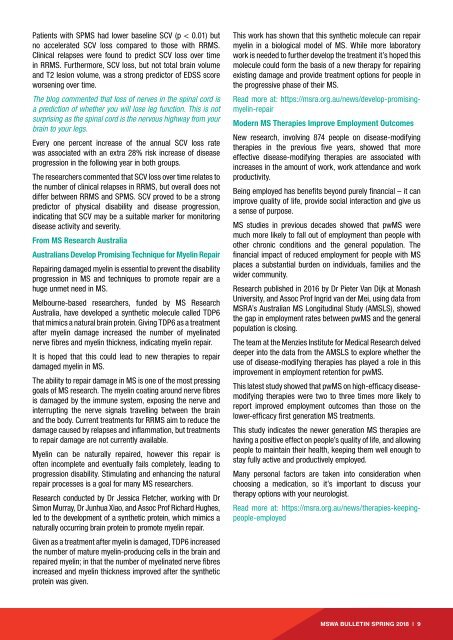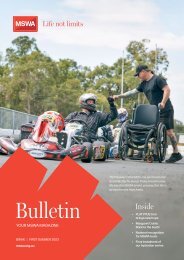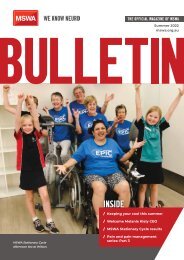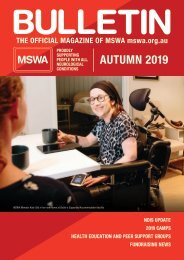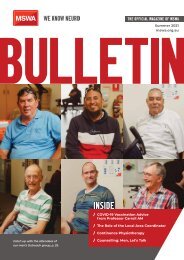Create successful ePaper yourself
Turn your PDF publications into a flip-book with our unique Google optimized e-Paper software.
Patients with SPMS had lower baseline SCV (p < 0.01) but<br />
no accelerated SCV loss compared to those with RRMS.<br />
Clinical relapses were found to predict SCV loss over time<br />
in RRMS. Furthermore, SCV loss, but not total brain volume<br />
and T2 lesion volume, was a strong predictor of EDSS score<br />
worsening over time.<br />
The blog commented that loss of nerves in the spinal cord is<br />
a prediction of whether you will lose leg function. This is not<br />
surprising as the spinal cord is the nervous highway from your<br />
brain to your legs.<br />
Every one percent increase of the annual SCV loss rate<br />
was associated with an extra 28% risk increase of disease<br />
progression in the following year in both groups.<br />
The researchers commented that SCV loss over time relates to<br />
the number of clinical relapses in RRMS, but overall does not<br />
differ between RRMS and SPMS. SCV proved to be a strong<br />
predictor of physical disability and disease progression,<br />
indicating that SCV may be a suitable marker for monitoring<br />
disease activity and severity.<br />
From MS Research Australia<br />
Australians Develop Promising Technique for Myelin Repair<br />
Repairing damaged myelin is essential to prevent the disability<br />
progression in MS and techniques to promote repair are a<br />
huge unmet need in MS.<br />
Melbourne-based researchers, funded by MS Research<br />
Australia, have developed a synthetic molecule called TDP6<br />
that mimics a natural brain protein. Giving TDP6 as a treatment<br />
after myelin damage increased the number of myelinated<br />
nerve fibres and myelin thickness, indicating myelin repair.<br />
It is hoped that this could lead to new therapies to repair<br />
damaged myelin in MS.<br />
The ability to repair damage in MS is one of the most pressing<br />
goals of MS research. The myelin coating around nerve fibres<br />
is damaged by the immune system, exposing the nerve and<br />
interrupting the nerve signals travelling between the brain<br />
and the body. Current treatments for RRMS aim to reduce the<br />
damage caused by relapses and inflammation, but treatments<br />
to repair damage are not currently available.<br />
Myelin can be naturally repaired, however this repair is<br />
often incomplete and eventually fails completely, leading to<br />
progression disability. Stimulating and enhancing the natural<br />
repair processes is a goal for many MS researchers.<br />
Research conducted by Dr Jessica Fletcher, working with Dr<br />
Simon Murray, Dr Junhua Xiao, and Assoc Prof Richard Hughes,<br />
led to the development of a synthetic protein, which mimics a<br />
naturally occurring brain protein to promote myelin repair.<br />
Given as a treatment after myelin is damaged, TDP6 increased<br />
the number of mature myelin-producing cells in the brain and<br />
repaired myelin; in that the number of myelinated nerve fibres<br />
increased and myelin thickness improved after the synthetic<br />
protein was given.<br />
This work has shown that this synthetic molecule can repair<br />
myelin in a biological model of MS. While more laboratory<br />
work is needed to further develop the treatment it’s hoped this<br />
molecule could form the basis of a new therapy for repairing<br />
existing damage and provide treatment options for people in<br />
the progressive phase of their MS.<br />
Read more at: https://msra.org.au/news/develop-promisingmyelin-repair<br />
Modern MS Therapies Improve Employment Outcomes<br />
New research, involving 874 people on disease-modifying<br />
therapies in the previous five years, showed that more<br />
effective disease-modifying therapies are associated with<br />
increases in the amount of work, work attendance and work<br />
productivity.<br />
Being employed has benefits beyond purely financial – it can<br />
improve quality of life, provide social interaction and give us<br />
a sense of purpose.<br />
MS studies in previous decades showed that pwMS were<br />
much more likely to fall out of employment than people with<br />
other chronic conditions and the general population. The<br />
financial impact of reduced employment for people with MS<br />
places a substantial burden on individuals, families and the<br />
wider community.<br />
Research published in 2016 by Dr Pieter Van Dijk at Monash<br />
University, and Assoc Prof Ingrid van der Mei, using data from<br />
MSRA’s Australian MS Longitudinal Study (AMSLS), showed<br />
the gap in employment rates between pwMS and the general<br />
population is closing.<br />
The team at the Menzies Institute for Medical Research delved<br />
deeper into the data from the AMSLS to explore whether the<br />
use of disease-modifying therapies has played a role in this<br />
improvement in employment retention for pwMS.<br />
This latest study showed that pwMS on high-efficacy diseasemodifying<br />
therapies were two to three times more likely to<br />
report improved employment outcomes than those on the<br />
lower-efficacy first generation MS treatments.<br />
This study indicates the newer generation MS therapies are<br />
having a positive effect on people’s quality of life, and allowing<br />
people to maintain their health, keeping them well enough to<br />
stay fully active and productively employed.<br />
Many personal factors are taken into consideration when<br />
choosing a medication, so it’s important to discuss your<br />
therapy options with your neurologist.<br />
Read more at: https://msra.org.au/news/therapies-keepingpeople-employed<br />
MSWA BULLETIN SPRING <strong>2018</strong> | 9


